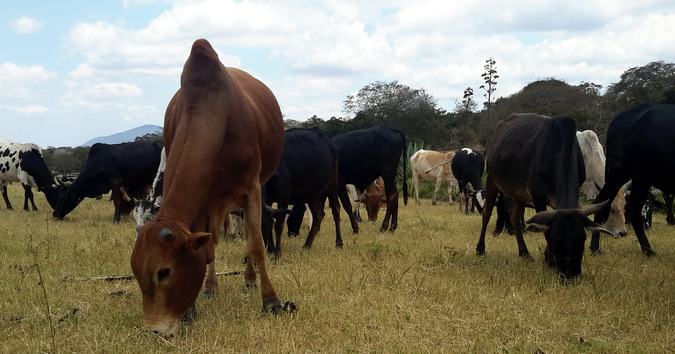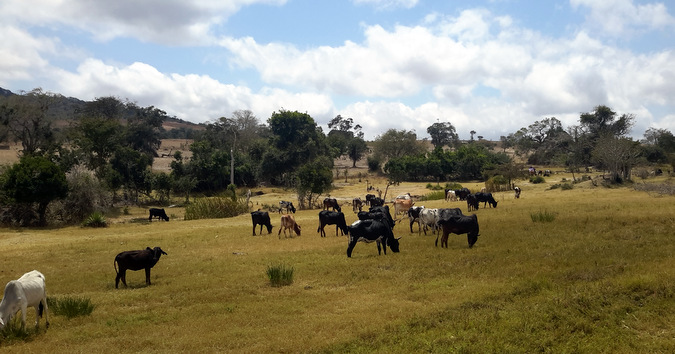
Comment from the editors: For the Maasai people, cattle are considered extremely valuable and form an intrinsic part of their daily lives. Their cattle are at the centre of everything, providing them with food and materials, as well as playing an important role in their rituals and representing their wealth and status. For those of us living in urban areas, it is important to understand the Maasai culture, where the need to protect and care for their cattle is paramount.
Stephanie, who is married to a Maasai warrior, shared with us her video of the Maasai warriors watering their cattle. Some interesting comments were raised from our audience about the video, one such comment suggesting that cattle destroy the African savannah. Stephanie now provides her own unique insight and thoughts about the Maasai, their cattle, and the effects of overgrazing and overpopulation:

Stephanie Fuchs: “I used to be a conservationist and in some ways I still am, even though many of you will tell me that that is a lie, seeing as I live with the Maasai tribe whose cattle cause overgrazing and desertification of Tanzania’s woodlands and savannahs.
The surprising truth is though, that I have learned so much about the issues surrounding conservation by living in rural Tanzania with a tribe that tries to hold on to their traditional way of life.
From what I have learnt, the Maasai used to be very few – probably due to the harsh environment they lived in without access to clean water, food and shelter, but mainly because they used to be a warring tribe.
Warriors, or Moran in Maa, used to roam the plains of modern-day Ethiopia, Sudan and Kenya looking for cattle to steal from their neighbouring tribesmen. They used to wage wars for pasture lands, cattle and water. They could be out for months at a time and many of those who left would never return home, having died in battle or of hunger.
The Moran’s life expectancy was short and they were not allowed to marry until they were old enough to become ‘old men’. Many of them died without ever having fathered children. Women died due to circumcision or in childbirth. Birth rates were low and infant mortality high.
These days, due to the changing times, Maasai populations have grown considerably. You could say that the factors that brought this about are in the form of laws and regulations, police control and the institution of ‘order’, of peace talks between warring tribes, and the development of infrastructure in the form of schools and health care facilities.
Warriors have stopped warring, are marrying earlier, living longer lives and having children. Circumcision is no longer legal, and maternity care is offered to women. Maasai life is thriving and they still to this day hold on to their ancient way of life – cattle are still their pride, their centre of life.
Many Maasai, therefore, mean many cattle, which leads to potential overpopulation and overgrazing, causing a decline of local wildlife.

The Maasai love and respect nature (and never hunt wildlife), and I have come to understand that in the past they used to live in harmony with nature, cherishing Enkai, a higher spirit which would make the heavens open and bring life back to the savannah and make grass sprout again for their cattle to feed on after the dry season. They used to understand the balance of life, used to read the stars and navigate by the sun. Wildlife around them used to thrive as they would neither hunt nor disturb it in any sort of way.
Nowadays, so much of their traditions, their stories and their wisdom have been lost, covered by the desire to fit in, to adapt to modern life.
Unfortunately, due to overpopulation, land is becoming sparse and hunger is more frequent. People fight over farms and grazing land, and cattle don’t have enough grass to feed on.
In my opinion, too little has been done to help the Maasai deal with keeping the balance between a traditional lifestyle and the pressure caused by an ever-increasing human population. I believe that they have not been taught how to effectively manage their land and resources. Health care facilities are numerous and maternity care is making a difference for women’s lives, but should there not be a stronger focus on education about birth control and family planning in the name of sustainability?
Even today, despite the education they receive, the Maasai take pride in having large families. It is common for women to have eight children. I think it is right here where efforts to preserve the Maasai’s culture, along with the environment they live in, have to be focused.
So, is it fair to blame the Maasai and their cattle alone for the destruction of the wilderness they live in? I, for my part, think not.
Living with them has taught me that conservation is not only about animals, but is just as much about us humans. To preserve any one place we have to be mindful of the local communities that live within it and try to understand the way they view the world and mother nature.
I have come to believe that our world’s beauty consists of the diversity of its flora and fauna and that we, as humans, are as much part of this fauna as are lions and elephants.
I came to Africa as a conservationist and her people turned me into an anthropologist. For me, there is no choosing one over the other.”
To comment on this story: Login (or sign up) to our app here - it's a troll-free safe place 🙂.![]()






